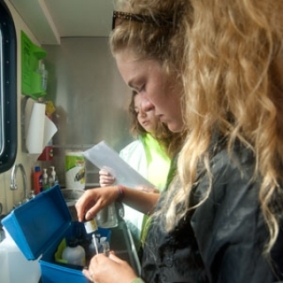Eight students will be presenting the summer work at the Ocean Sciences Meeting in March 2022!
Chloe Anderson, Indiana University Bloomington
Class Year:
2013Mentor:
Christopher Rowe, Ph.D.Project Title:
Measured Responses of Gray Tree Frog (Hyla versicolor) Tadpoles to Selenomethionine and Selenium Dioxide
Abstract:
Selenium (Se) is a contaminant of concern in areas affected by coal ash disposal and runoff from seleniferous soils, and may occur in inorganic or organic forms. To quantify the different effects of organic and inorganic selenium, we dosed the food of gray tree frog (Hyla versicolor) tadpoles with selenium dioxide at concentrations of 16.27 and 34.2 μg g-1 Se dw and selenomethionine (SeMet) concentrations of 14.23 and 32.8 ug g-1 Se dw. As tadpoles accumulated Se throughout metamorphosis, we measured biological endpoints including metabolic rate, survival, and growth. A behavioral test was also administered. Chemical analyses on total accumulated Se and mercury (Hg) have yet to be completed. Analysis of food was done via chemical digestion and mass spectrometry. Midpoint respirometry analysis showed that SeMet high tadpoles had significantly higher metabolic rates in μl O2 g-1 min-1, with a mean of 3.26, than control (mean=2.20, p=0.0024), SeO2 low (mean=2.52, p=0.0337), and SeMet low (mean=2.66, p=0.0176) tadpoles. No further significance was found regarding respirometry, growth, survival, or behavior. However, survival to the end of the study was lowest for SeMet high and SeMet low tadpoles, suggesting organic Se had more toxic effects. SeO2 did not appear to be toxic, but because of the possibility of conversion to an organic form in a natural ecosystem, efforts to restrict release of Se rich wastes are warranted.




